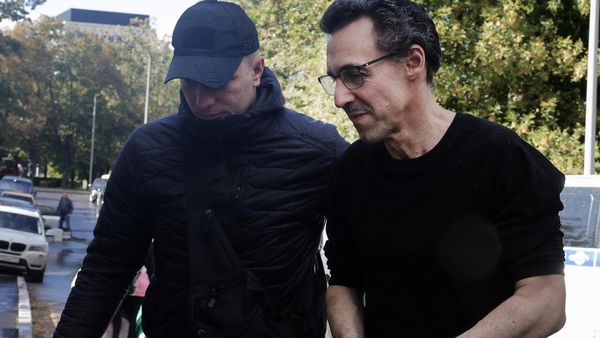If you’re an NBA fan who hasn’t watched a minute of college basketball this season, welcome to the party. SI’s annual NCAA tournament scouting guide is back again, highlighting the players and games to watch, whether or not you have a vested interest in a tanking team.
This is actually one of the better years to scout the tournament in recent memory, with the vast majority of top prospects playing on teams that made the field. Using February’s most recent Big Board update, 50 of SI’s top 60 prospects played college basketball this season, and just eight of them were on teams that missed the tournament. Then subtract Shaedon Sharpe, who isn’t actually playing for Kentucky right now, and that’s 41 prospects in action this week. It’s a great time to get caught up before the predraft process gets rolling.
With all that in mind, here’s the latest on a range of top prospects in the tourney, and what you should pay attention to this week and beyond.
West Region
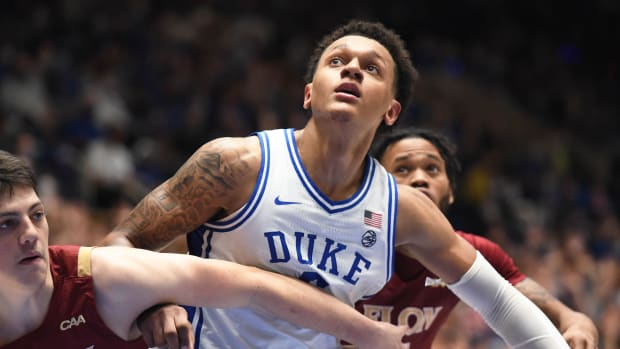
Rob Kinnan/USA TODAY Sports
Top prospects: Chet Holmgren, Gonzaga; Paolo Banchero, Duke
If your favorite NBA team is tanking, pay close attention: the West is headlined by two of SI’s projected top three prospects in Holmgren and Banchero, who memorably went head-to-head in November and could face off again in the Elite Eight if the chalk holds. Auburn’s Jabari Smith Jr. remains the safest bet to go No. 1 in June, but both Holmgren and Banchero enter the tourney with things to prove as they jostle for draft position as one-and-done freshmen.
Holmgren has received quite a bit of hype nationally, and his impact on the Bulldogs’ success is undeniable, but opinions I’ve heard around the NBA vary more widely than one might assume from what you hear and read elsewhere. Holmgren has played well this season and is still trending toward a top-three selection: listed at 7'0”, 190 with a 7'6” wingspan, he’s a high-quality defensive prospect who projects best not at center, but as more of a roving, shot-blocking four-man, and preferably alongside a stronger, more physical big. That role will enable him to use his length around the rim and as a rebounder while limiting how much his lack of strength can be exposed. While opponents have had success attacking him in the post, his impact on the defensive end has been consistent and enhances the perception that Holmgren has a comfortable value floor in the pros. If you assume his defense translates meaningfully, then Holmgren can be pretty valuable even if he never expands his offensive repertoire much.
Right now, he is a threat to finish lobs and has had success pushing the ball in transition, though he may not win open-court foot races in the NBA. He projects as a reliable jump shooter, but can be streaky: Holmgren is making 41% of attempts from distance, but has shot just 27% from deep in 12 games against Tier A opponents (as classified by KenPom). He’s highly efficient (70.4 TS%), but NBA execs have been watching closely to see how Holmgren deals with opponents that counter him with appreciable size and strength. He played poorly in Gonzaga’s two recent games against Saint Mary’s, which made a concerted effort to hit him early and more or less neutralized him on offense. Potential matchups against Memphis, UConn, Texas Tech or Duke, physical teams that can make him uncomfortable, would be analyzed closely. The NBA places much more stock in those settings: Holmgren can enhance his case as a top prospect with strong showings in those types of games, or raise more questions if he struggles.
As for Banchero, opinions I’ve heard have been vacillating over the past six weeks after some middling performances: he is no longer as much of a real candidate at No. 1, but remains a good bet to go in the top five. I spent three days last week at the ACC tournament evaluating Banchero and a Duke team with five projected first-rounders. He’s supremely skilled for his size and at his best when he keeps the game simple, making quick decisions and allowing his passing vision and delivery to shine while attacking mismatches. While Banchero isn’t a rim protector, I thought his effort defensively and on the glass improved over the course of the week. He remains a great fit for positionless offense who will complement better players on a good team, as long as he shoots.
Unfortunately, Banchero appears to be going through a present crisis of faith in his jump shot, which NBA scouts agree was in a much better place back in November. In a vacuum, it’s a good idea for him to pare down his shot selection, but he’s developed an inconsistent, minor hitch at the top of his release, and seems to be lacking for confidence at the foul line and from three-point range. This is something he can absolutely iron out over time, but in the short-term, it makes him a lot easier for opponents to defend. It’s also a part of his eval that potential suitors have to think hard about: if Banchero doesn’t comfortably project as a good jump shooter in the long haul, it will be much harder to leverage mismatches with his his average explosiveness, keep defenses honest, and generate easy buckets. Ultimately, his versatility gives him too many pathways to success to be overly worried, but better shooting performances in the tourney would help assuage these concerns.
Prospect with the most at stake: Blake Wesley, Notre Dame
Among non-household names, Wesley has been one of the more interesting freshmen to track this season, having flashed some major upside at times after arriving at his hometown school mostly off the radar. He turns 19 on Wednesday, when the Fighting Irish take on fellow 11-seed Rutgers in the First Four for the right to face Alabama in the first round. As a big, toolsy guard whose skill set remains rough around the edges, Wesley is in a position somewhat similar to that of Jaden Ivey a year ago: his upside would likely land him in the first round, but he could touch immediate stardom if he stays in college.
Financially speaking, there’s money waiting for him in the NBA, but there are fair questions as to whether Wesley is ready, fully evidenced by a forgettable showing last week at the ACC tourney that led to Mike Brey benching him for most of the second half. I had a front-row seat for that one, and it was obvious up close how much he has to improve in terms of decision-making and court vision to have any chance of impacting a game in the league next season. Opinion varies on him around the league to where this is not a clear-cut choice. But if Wesley can spark Notre Dame to a win or two in the tourney and end the year on a better note, it could strengthen his position.
Sleeper to watch: Keon Ellis, Alabama
Ellis doesn’t receive much attention nationally, let alone on his own team, but the senior wing has been one of my favorite sneaky prospects all season. On a sixth-seeded Alabama team prone to emotional swings and inconsistent play, Ellis stands out for his steadiness and effort, and projects as a willing role player who impacts games as a floor spacer and high-energy defender. He doesn’t create much in the halfcourt, but he’s efficient with the touches he gets, he’s an underrated passer, and he’s athletic and skilled enough to play with others in transition. Other than the fact he’s 22 and weighs only 175 pounds (by my estimation, pure muscle), Ellis deserves long looks in the 25-40 range of the draft.
Second round game to wish for: (1) Gonzaga vs. (9) Memphis
Watching Holmgren square off against Tigers freshman center Jalen Duren, another potential lottery pick whose game couldn’t be more different, would be entertaining and potentially instructive. Duren is a bruising catch-and-finish big with some skill potential and a chiseled frame, who relies on his physical dominance but whose motor can come and go. He’s been playing better lately and would have an opportunity to dominate the paint against Gonzaga, which has enough size but not the same type of athleticism up front with Holmgren and Drew Timme. Memphis has to beat a quality Boise State team first.
Regional matchup scouts want: (1) Gonzaga vs. (2) Duke
Another chance to see Holmgren and Banchero head-to-head would be a best-case scenario, particularly considering the trajectories of their respective seasons. I was there in Vegas when they played in November: Banchero dominated that game before exiting due to second-half cramps, and Holmgren was almost a non-factor in the first half and didn’t play as well as the box score showed. Since then, Holmgren’s play has trended up while Banchero has flatlined a bit. Neither team has an easy route to the Elite Eight, but a rematch would be must-watch for scouts and fans alike. Also, Duke has four other potential first-rounders, with the quartet of A.J. Griffin, Wendell Moore, Mark Williams and Trevor Keels.
East Region
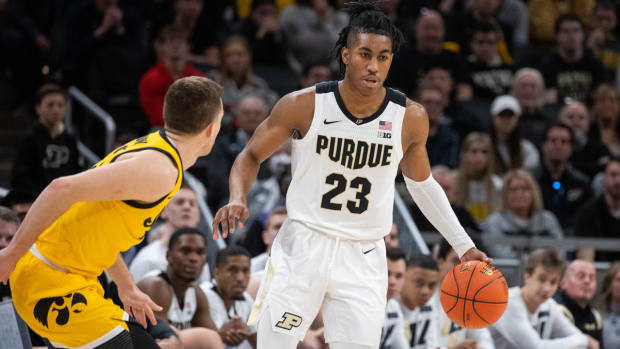
Top prospect: Jaden Ivey, Purdue
Ivey made himself a national name with a breakout sophomore season and has put himself in position to be the first guard drafted, coming in at No. 4 on our most recent Big Board. He has a case as the best pure athlete in college basketball, coupling unusual open-court explosiveness with the ability to decelerate and change directions off of long strides. That makes him near-impossible to stop with a full head of steam, and generally negates the fact he doesn’t have much of a left hand. It’s easy to look at Ivey and see starry upside if he can evolve into a full-time lead guard, and he’ll have a physical advantage from day one in the NBA. He’s not a great defender, but he should be able to turn that on when he needs to.
Having said all that, it hasn’t all been smooth sailing for Ivey and his team this season. Purdue faces a tough pathway to the Final Four, presenting a runway for a major star turn from Ivey or conversely, a precipitous exit. It’s pretty hard to keep him out of transition, but it’s not all that complicated to gameplan for him in the halfcourt, which even weaker teams have been able to do this season. If opponents can slow the game down, the concepts are fairly simple: try and force Ivey left, show him bodies at the rim, and try to make him stop and think in the midrange, where he lacks a reliable jumper or floater and can be prone to turnovers. If you do that, you can live with the results. Ivey’s decision-making skills haven’t shown much improvement over the course of the season and his three-point shooting clip regressed to 35.6% after he made just 30.9% of them in conference play.
While you can argue his upside might put him at the very top of this draft class, NBA execs I’ve spoken with have grown more concerned with that aspect of Ivey’s game as the season has gone on. His body language and leadership have come into question at times, in addition to his decision-making in close games. Rightfully or not, the pressure situations Ivey will likely face in the tournament will put a magnifying glass on those habits, which have been a trend all season. If he’s able to lead Purdue to the second weekend and beyond, he might help himself on that front.
Prospect with the most at stake: Jeremy Sochan, Baylor
Many teams were quietly hoping Sochan would fly below the radar this season, but an injury to Bears center Jonathan Tchamwa Tchatchoua thrust the 18-year-old freshman into an even more crucial role, and he’s answered the call. His feel for the game is highly advanced, he’s athletic enough to potentially guard five positions, and he may only be a consistent jumper away from a high-impact NBA role. Along with a huge contingent of NBA execs and scouts, I was lucky enough to catch Sochan’s best game of the season against Kansas on Feb. 26, in which Scott Drew pivoted mid-game and essentially let Sochan moonlight as a point guard, forcing the Jayhawks to defend the two-man game and turning the tide.
There are nights where it’s obvious Sochan isn’t just Baylor’s best prospect, but its best player, and you wonder if the Bears eventually turn to him as a playmaker again in a pinch. We ranked Sochan at No. 11 on last month’s Big Board, and while he’s pretty safely a first-rounder right now, it’s easy to envision him continuing to trend up, in the way that similarly versatile forwards Scottie Barnes and Patrick Williams did in the last two drafts. His teammate, Kendall Brown, is another likely first-rounder to keep an eye on. Sochan and Brown could draw matchups against potential draft picks Justin Lewis of Marquette and Jaime Jaquez of UCLA in consecutive rounds, too.
Sleeper to watch: Jaime Jaquez, UCLA
Speaking of Jaquez, you may remember him from UCLA’s unexpected run to last year’s Final Four. While it feels weird labeling anyone from UCLA as a sleeper, he still doesn’t get enough credit for how good he is. While not a super athlete, the 21-year-old junior forward is extremely tough and has played through various injuries for most of the season. While his three-point shot hasn’t been great, he’s certainly looked better of late, averaging 23.4 points and 8.2 rebounds over his last five games and re-emerging as his team’s best player. He doesn’t have tremendous upside, but his all-around game and intangibles make Jaquez a great bet to stick in the NBA long term, and a potential late first-rounder if he enters the draft.
Second round game to wish for: (3) Purdue vs. (11) Virginia Tech
The Boilermakers should be reasonably expected to handle 14-seed Yale in the first round, but if Purdue draws a disciplined Virginia Tech team that just beat Duke to win the ACC tournament, it should face a staunch test. The Hokies’ only NBA prospect is 6'9" Keve Aluma, whose game is likely better suited for Europe, but they’re well coached, run excellent offense and can take particular advantage of teams that don’t communicate or defend screens effectively. That could be trouble for Purdue, who in addition to Ivey, deploy a pair of potential second-round picks at center, platooning 7'4" Zach Edey with 6'10" Trevion Williams. Virginia Tech’s bigs will likely challenge those guys by stepping out to the perimeter, and a potential high-pressure ending would present a good challenge for Ivey, who will have to step up in these moments. The Hokies have to beat Texas first, and for the purposes of this exercise, the Longhorns are also capable of giving Purdue problems.
Regional matchup scouts want: (1) Baylor vs (3) Purdue
Yes, Kentucky is also in this region, but the Wildcats aren’t rife with high-end NBA talent this year, with freshman TyTy Washington the only likely first rounder and junior Oscar Tshiebwe projected in the second. A Kentucky-Purdue Sweet Sixteen game would be fun, but objectively, it would be more interesting to see Ivey and Purdue face Baylor one round later. The Bears wield a ton of size and versatility across the frontcourt with Sochan and Brown, alongside experienced guards Adam Flagler and James Akinjo. With Sochan, Brown and Flagler, the Bears are one of the few teams in the country that could reasonably throw a range of defenders and schematic twists at Ivey to some effect.
South Region
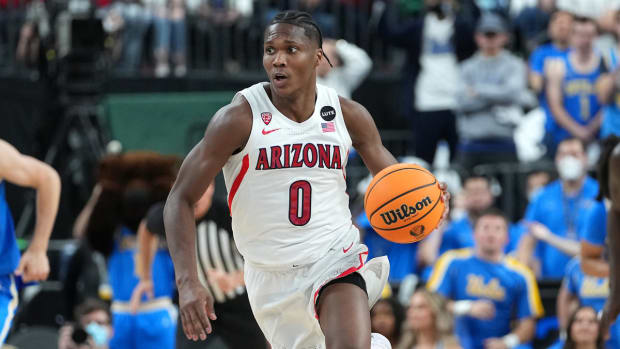
Stephen R. Sylvanie/USA TODAY Sports
Top prospect: Bennedict Mathurin, Arizona
The No. 9 prospect on SI’s most recent draft board, Mathurin headlines a fast-paced Arizona team that has a real chance to win it all and has enjoyed a monster season playing a style that fits him perfectly. He’s not the type of two-guard who can consistently break off plays and take over by himself, but the Wildcats are unselfish, move the ball and feed him in transition, where his world-class athletic ability makes him a devastating finisher. The sophomore is also a good catch-and-shoot player and has expanded his playmaking acumen for teammates a bit, making him even more effective on an Arizona squad that shares opportunities and plays democratically in search of the best shots. (Per KenPom, the Wildcats assist on 65.4% of baskets, the top mark in the nation.)
Where Mathurin tends to struggle is in situations that require him to improvise, which likely limits some of his upside as an on-ball playmaker in the pros. He’s also not as impactful defensively as you’d think for someone with his caliber of athletic tools. But the role he’s playing now should be pretty similar to what he’ll do in the NBA, as a supporting scorer who can fit in without hurting his team in any glaring way. And while the Wildcats are currently missing injured guard Kerr Kriisa—who likely won’t be 100 percent if he returns—they have enough guard talent that Mathurin shouldn’t be stretched beyond his means.
Arizona has a fairly agreeable path to the Final Four, with Villanova, Tennessee and Illinois the three other high seeds in the region, none of whom can match their personnel in the truest sense. But when other teams inevitably try to boil games down to the halfcourt, Mathurin will be asked to step up and make shots. He’s a pretty solid lottery option right now, but a strong individual run will bolster that case.
Prospect with the most at stake: Malaki Branham, Ohio State
Branham hit the NBA radar with an incredibly impressive 35-point performance on Jan. 2 against Nebraska, and has gradually become a pivotal player for the Buckeyes, who have struggled going into the tourney and need to get right quickly before a tough first-round tilt against Loyola. Still just 18 years old, Branham has played his way from lesser-known freshman into one-and-done territory, with terrific balance and touch on his jumper and a mature, focused approach to scoring. He’s capable of taking over games when called upon, having scored 20-plus points in Ohio State’s last three wins, but on Friday will likely have to navigate a matchup with Loyola’s Lucas Williamson, an experienced, tough defender and viable NBA sleeper.
While it’s not certain Branham will leave for the draft—my understanding of the situation was that he originally planned to spend two years at Ohio State—considering the way things have been trending, it won’t be a surprise if he enters. There’s enough pedigree and production here, particularly relative to other struggling freshmen, to justify taking a chance. Branham came in at No. 26 on the last Big Board, and could rise from there in the predraft process. But first, he and projected first-rounder E.J. Liddell will need to pull things together and get the Buckeyes rolling again.
Sleeper to watch: David Roddy, Colorado State
Roddy and the Rams have the potential to become a March darling, with an entertaining offensive attack that covers for their lack of size up front with patient decision-making and potent shooters. Michigan’s size presents a tricky first-round matchup, but CSU can hang with most teams when it makes threes, paced by Roddy and his 45% clip from long distance. The 6'6" forward is undersized for an NBA four-man, but he’s got real skill with the ball, passes well, and can overpower smaller defenders with his hefty frame. It’s not a foregone conclusion he leaves for the draft, but the junior has proven he’s not a gimmick, and a hot March would certainly highlight his versatility and unique skills.
Second round game to wish for: (3) Tennessee vs. (6) Colorado State
The South isn’t the most prospect-heavy region, but a meeting between the Volunteers and Rams in Indianapolis would be a good forum for Roddy and Tennessee freshman point guard Kennedy Chandler to showcase their games. Currently a projected second-rounder on SI’s board, Chandler has been playing well of late and spurred the Vols to the SEC tournament title with hot shooting. He’s been a little inconsistent in that department overall and has a tiny frame (6'0”, 170) that suggests he profiles better as an NBA backup. Not every team will want to draft an undersized guard like Chandler, but his blazing speed and overall moxie allow him to really impact games when he has it going. He’d draw an interesting matchup with Colorado State’s Isaiah Stevens, who’s been a steady distributor and scorer all season.
Regional matchup scouts want: (1) Arizona vs. (4) Illinois
The Wildcats and Illini met on Dec. 11 in what became one of the best non-conference games of the season, and a four-point true road win that cemented Arizona among the top teams in the country. Both teams would be well-prepared for a Sweet 16 rematch, with Illinois having figured some things out of late and Arizona unlikely to be caught sleeping. The center matchup between Wildcats sophomore Christian Koloko, a projected top 40 pick, and Illinois junior Kofi Cockburn, who was neutralized by Koloko last time, would be at the forefront of this one. The Illini don’t have a direct answer for Bennedict Mathurin, but they play hard, are well-coached, and have shown a lot of mettle at various junctures, which culminated in a share of the Big Ten regular season title. The familiarity should make this a terrific game if we get it.
Midwest Region
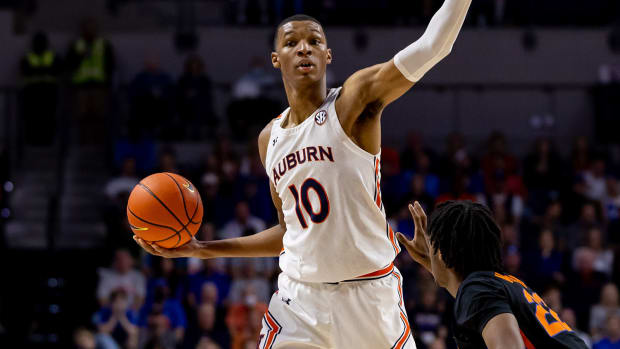
Matt Pendleton/USA TODAY Sports
Top prospect: Jabari Smith Jr., Auburn
As far as breadth and quality of NBA talent is concerned, the Midwest wound up as the most loaded region, with five of its top six seeds boasting at least one potential top 20 pick, including three of SI’s projected top six. That includes Smith, who is on track to hear his name called first on draft night and will try and lead Auburn to a title before he goes. Naturally, the 6'10" freshman is a must-watch, particularly for NBA fans tuning in to college basketball for the first time this season. He’s a potentially transcendent jump shooter with a strong fundamental game, untapped physical upside, and a sense of urgency on both ends of the floor. It’s not often you see all those traits in combination, and Smith couples that with strong intangibles—he values his teammates and understands how to score without being selfish. On top of all that, he won’t turn 19 for a couple more months.
Smith seems sure to have his moments this month, but how long Auburn survives in the bracket, even as a No. 2 seed, will hinge heavily on how well his guards perform. Wendell Green is the Tigers’ most talented guard, but can be streaky and shot-happy. It’s never exactly clear what they’re going to get from K.D. Johnson, other than the fact he plays extremely hard. Smith and projected first-rounder Walker Kessler, the nation’s top shot-blocker, give Auburn a ton of size and defensive backbone, which can cover for quite a bit against inferior opponents. But there are no easy games in the NCAA tournament, and the Tigers are going to have to find ways to get the ball to their best player when it matters.
Matchup-wise, there are several potentially interesting individual draws for Smith: facing USC in the second round would pit him against Isaiah Mobley, the older brother of Cavs rookie Evan Mobley who has the length and experience to match up with him. Auburn could potentially rematch with LSU in the Sweet 16, which has another projected first-rounder in forward Tari Eason. And if Iowa can pull some upsets and make it to the Elite Eight as a five-seed, we could get Smith against potential top-five pick Keegan Murray. (P.S. — watch Iowa too). All of these would be interesting tests for Smith, who isn’t a dynamic ball-handler but understands how to keep things simple and shoot over most opponents. At this point, he’s proven enough that his stock shouldn’t shift. But he’ll deserve the spotlight for as long as Auburn can hang around.
Prospect with the most at stake: Johnny Davis, Wisconsin
Davis is a likely top 10 pick no matter what and came in at No. 5 on our most recent Big Board, but his shooting struggles over the past couple months have been getting nitpicked by NBA teams. He was on a tear back in January and looked like arguably the draft’s best guard, and it’s worth keeping in mind he’s played through injuries all year, which includes a sprained ankle from a couple weeks ago against Nebraska that may have impacted his struggles in the Big Ten tournament. Davis is not the type of guy you want to doubt—he is intensely competitive, cares about winning and not stats, and has done quite a bit of heavy lifting for Wisconsin all season—but if he’s not 100 percent, the Badgers are more vulnerable.
The question this week will be whether Davis can rediscover the magic and stage a March takeover, which is in the realm of possibility, and would leave scouts with a reminder of what he can do at his best. Even if he’s not scoring efficiently, Davis is an excellent rebounder, willing defender and capable playmaker for teammates, and gives Wisconsin the best player on the floor in nearly any matchup. His stock may be fluctuating a tiny bit within the lottery right now, but there’s an opportunity for him to make a statement.
Sleeper to watch: Baylor Scheierman, South Dakota State
South Dakota State looks like a popular upset pick against a relatively weak No. 4 seed in Providence, with a high-powered offense anchored by Scheierman, a 6'6" sophomore guard who plays on the ball and does it all for his team as a scorer, rebounder and playmaker. The Summit League isn’t exactly the pinnacle of college hoops, but Scheierman’s individual numbers pop in statistical models and have earmarked him as a fringe NBA prospect and someone teams will keep an eye on in the tournament. If the 13-seed Jackrabbits can pull an upset, they may get Iowa and Keegan Murray in the second round.
Second round game to wish for: (3) Wisconsin vs. (6) LSU.
LSU has only one projected draftee in Tari Eason (No. 24 on my last board), but their athleticism and high-pressure defense would pose a fascinating test for Wisconsin and Johnny Davis, assuming both teams win their first-round game. The Badgers have faced their share of terrific defenses in the Big Ten, but the Tigers like to blitz teams with ball pressure and have the second-best forced turnover rate in the country (25.3%) per KenPom. This could be a real trouble spot for Wisconsin if Davis isn’t at his best, but it could also be a meaningful proving ground for him as he navigates a potentially frenetic environment.
Regional matchup scouts want: (2) Auburn vs (5) Iowa.
Apologies to top seed Kansas, which stars projected first rounder Ochai Agbaji and another likely draftee in Christian Braun, but the most interesting scenario here involves Iowa getting hot and meeting Auburn in the Elite Eight, pitting Keegan Murray head to head against Jabari Smith. This is one of the most fun scouting scenarios potentially on the table, giving Smith maybe his toughest defensive assignment of the year in the 21-year-old Murray, who does damage in all facets of the game with a nonstop approach, and requires focused defensive effort to have any hope of slowing him down. Smith is one of the few forwards in college who could reasonably match up on Murray with his size and length. Sign me up.

